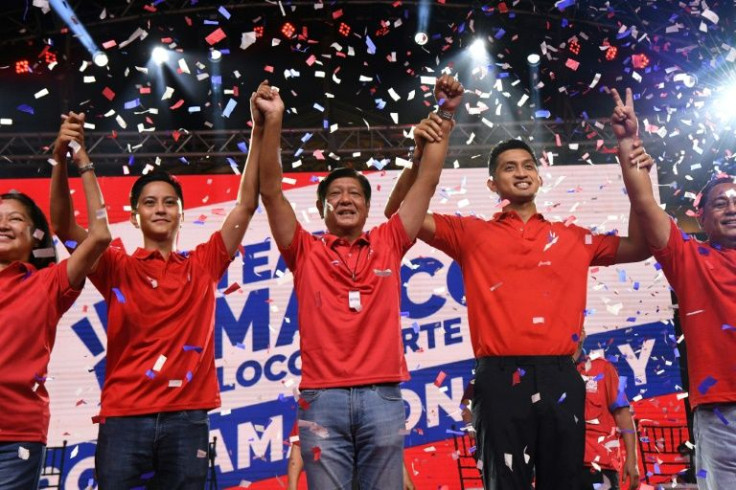'Golden Age': Marcos Myths On Philippine Social Media
Ferdinand Marcos Junior appears on the cusp of victory in next week's presidential polls, with his seemingly unassailable lead fuelled by a decades-long misinformation campaign to revamp the family brand.
The clan's comeback from pariahs in exile to the peak of political power has been built on a relentless barrage of fake and misleading posts on social media.
Pro-Marcos pages have sought to rewrite the family's history, spreading fallacies about everything from the patriarch's dictatorship to court rulings about the billions of dollars stolen from state coffers.
AFP's Fact Check team has debunked many of the myths swirling around the Marcoses.
Here are five of the most shared:
An alleged attempt to kill Marcos Jr ignited social media at the beginning of February, days before the presidential election campaign season kicked off.
A video posted on a Facebook account named Anti bias, which has repeatedly attacked Marcos Jr's main rival Leni Robredo and her opposition party, showed a news report about a bullet hole in a window of Marcos Jr's office.
It was viewed more than three million times.
But AFP fact-checkers found the video was more than six years old.
It had been taken from a news report published by GMA News on its social media accounts in August 2015 when Marcos Jr was a senator.
On the presidential campaign trail, Marcos Jr has shunned most media interviews and largely ignored journalist questions at rallies.
Yet multiple posts swarming social media claim he is the one being ignored.
A video posted on YouTube on March 16 asserted that Marcos Jr's rally in the northern province of Nueva Ecija was "not covered by the media".
The clip was viewed more than 23,000 times after it was posted by a YouTube channel called Showbiz Fanaticz, which has a history of peddling election-related misinformation.
But the reality was very different.
Local broadcaster ABS-CBN and other news outlets including News5 and OnePH published video reports of the rally.
Another video posted on the Facebook page Para sa Pagbabago showed Marcos Jr speaking in 2014 about rebuilding efforts following Super Typhoon Haiyan.
It was shared 12,000 times and viewed 555,000 times, with many users commenting that the interview was not broadcast by the media.
But AFP fact-checkers found various news outlets had aired portions of the interview while other organisations produced reports based on his remarks.

Pro-Marcos pages have long sought to portray Ferdinand Marcos's dictatorship as a "golden age" of peace and prosperity, rather than a violent and corrupt regime that left the country impoverished.
One claim that the Philippines was the second-richest country after Japan during the Marcos regime was posted in March 2020 on the Facebook page DU30 MEDIA Network, which pretends to be a legitimate media outlet.
It was shared about 300 times.
AFP fact-checkers consulted experts who said the economic data from the Marcos years told a very different story.
Philippine gross domestic product actually went from being fifth in Asia at the start of the dictator's rule to sixth by 1985, as the country languished in a deep recession.
Another post on the Facebook page Bangon Bansang Maharlika in October 2020 claimed the elder Marcos and Filipino nationalist Jose Rizal set up the World Bank and the International Monetary Fund.
It was shared nearly a hundred times.
Both institutions were created in 1944, five decades after Rizal's death and 20 years before Marcos was elected president of the Philippines.
The Philippines' highest court said in 2003 that the legitimate income of Marcos and his flamboyant wife Imelda during their 20 years in power was $304,372.43.
Yet more than $658 million was found in their Swiss bank accounts, which the court ordered to be handed back to the government.
It was a fraction of the $10 billion estimated to have been plundered from state coffer during the regime.
But a Facebook account named Ghee Vin Walker posted a claim in 2018 that no court had ever ruled the Marcoses had stolen money from the treasury.
It was shared nearly 9,000 times.
Many Filipinos have been deceived into believing Marcos made his wealth when he was a lawyer, before becoming president.
One such claim posted on the Facebook page Gabs TV in September 2020 asserted Marcos received a massive gold payment from a client in 1949.
A misleading video posted on Facebook during the 2022 election campaign sought to downplay human rights abuses committed during the Marcos years.
Amnesty International estimates Marcos's security forces either killed, tortured, sexually abused, mutilated or arbitrarily detained about 70,000 opponents.
But the video shows the elder Marcos alleging the rights group did not visit the Philippines and had relied on "hearsay" in its reports about the abuses during his dictatorship.
It was shared more than 3,000 times and viewed 184,000 times.
Multiple historical accounts indicate Amnesty International visited the Philippines at least twice during the Marcos presidency.
© Copyright AFP {{Year}}. All rights reserved.





















